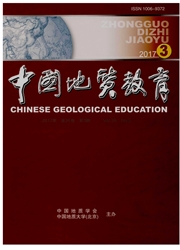

 中文摘要:
中文摘要:
Xiaoqinling 区域是在中国的一个重要金生产的区域。它关于金存款评价第二到 Jiaodong。Wenyu 花岗石的 pluton 的升起的时期和存款的墙岩石,对矿石探索重要。锆石的分裂轨道(英尺) 分析和从 Wenyu 花岗石的 pluton 的花岗石的岩石的磷灰石显示出那磷灰石英尺(在船尾) 当模特儿的数据显示 20 的快速的冷却率
 英文摘要:
英文摘要:
Xiaoqinling District is an important gold-producing area in China. It ranks second to Jiaodong with regard to gold deposits. The uprising period of the Wenyu granitic pluton and the wall-rocks of the deposit, as well as the mineralizing depth and reserved place of gold ore bodies, are significant to ore exploration. Fission-track (FT) analysis of zircons and apatites of granitic rocks from the Wenyu granitic pluton shows that apatite FT (AFT) data modeling indicates a rapid cooling rate of 20℃/Ma from 138 to 120 Ma after emplacement at 138 Ma. Thermal evolution and inversion curves suggest a secondary phase of fast cooling and up- rising from 45 to 35 Ma, and 35 Ma, respectively, with a cooling rate of 6.7℃/Ma and a denudation quantity of -4.3 km. The last cooling phase took place from 〈4 Ma, with an average cooling rate of -11.3℃/Ma and a denudation amount of 1.3 km. Total exhumation quantity of 5.6 km and uprising elevation of 7.3 km are similar to the estimated results of fluid inclusions from the Dongtongyu and Wenyu gold deposits. The 39Ar/40Ar dating of sericite from the fault planes of the Xunmadao-Xiaohe and Taiyao faults demonstrate two uprising activities of the ore-host metamorphic complex. The Huashan and Wenyu granitic plutons inten- sively occurred during 77 and 45 Ma, respectively. These data sets are valuable for understanding the uplifting process and for preserving gold ore bodies in the Xiaoqinling area, as well as for further studies on tectonic evolutions of the Taihua Complex and the Qinling-Dabie Orogen.
 同期刊论文项目
同期刊论文项目
 同项目期刊论文
同项目期刊论文
 Style of deep faulting and its control on the Paleogene basin evolved into the western Huimin depres
Style of deep faulting and its control on the Paleogene basin evolved into the western Huimin depres P-T paths derived from garnet growth zoning in the Danba domal metamorphic terrain, Sichuan Province
P-T paths derived from garnet growth zoning in the Danba domal metamorphic terrain, Sichuan Province Early Cretaceous extensional structures in the Liaodong Peninsula: structural associations, geochron
Early Cretaceous extensional structures in the Liaodong Peninsula: structural associations, geochron Geology of the Sandaowanzi telluride gold deposit of the northern Great Xing'an Range, NE China: Geo
Geology of the Sandaowanzi telluride gold deposit of the northern Great Xing'an Range, NE China: Geo Zircon SHRIMP U-Pb age of Yinmawanshan and Zhaofang pluton in South Liaoning metamorphic core comple
Zircon SHRIMP U-Pb age of Yinmawanshan and Zhaofang pluton in South Liaoning metamorphic core comple Formation and timing of the extensional ductile shear zones in Yiwulü mountain area, Western Liaonin
Formation and timing of the extensional ductile shear zones in Yiwulü mountain area, Western Liaonin 期刊信息
期刊信息
